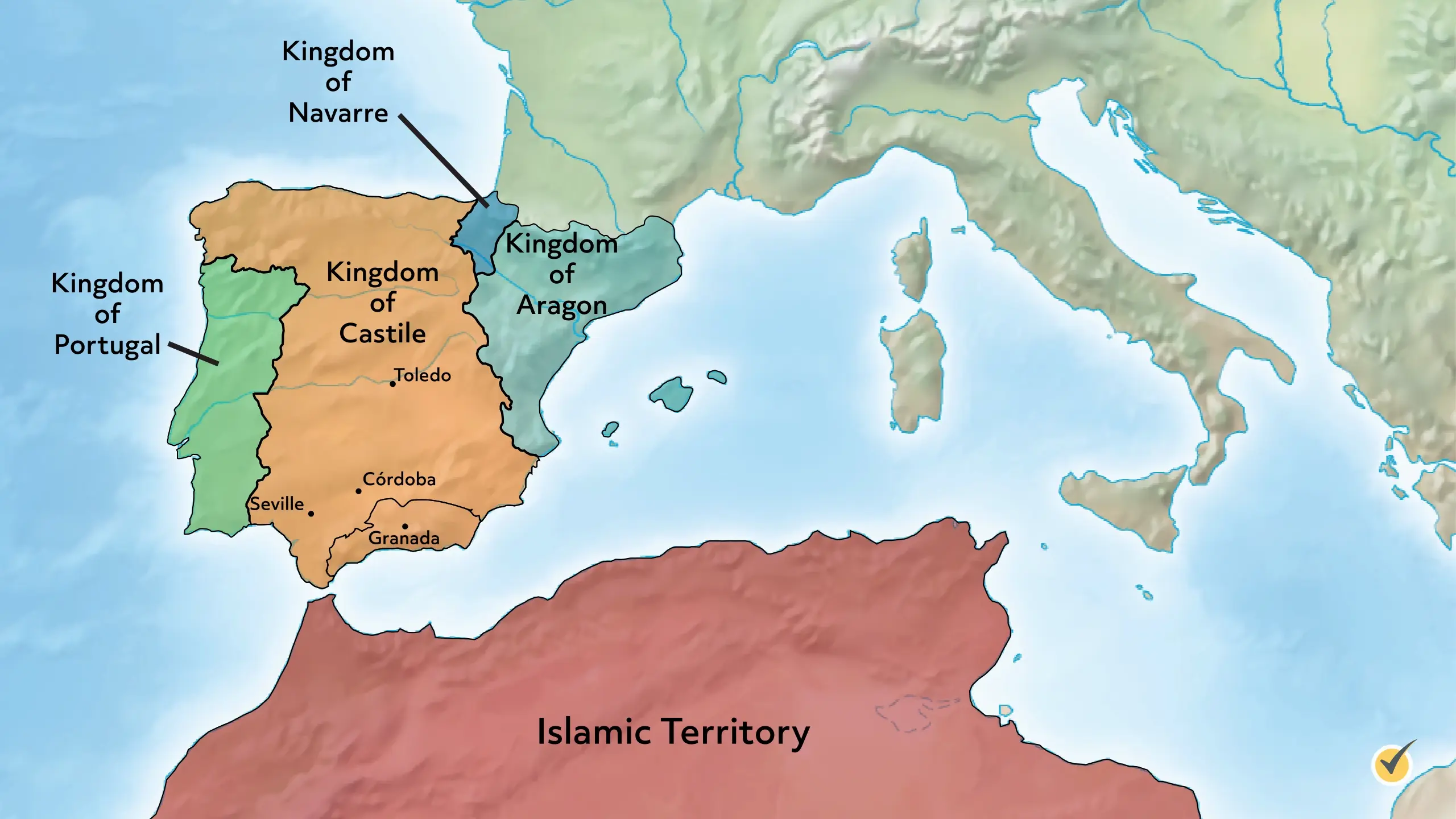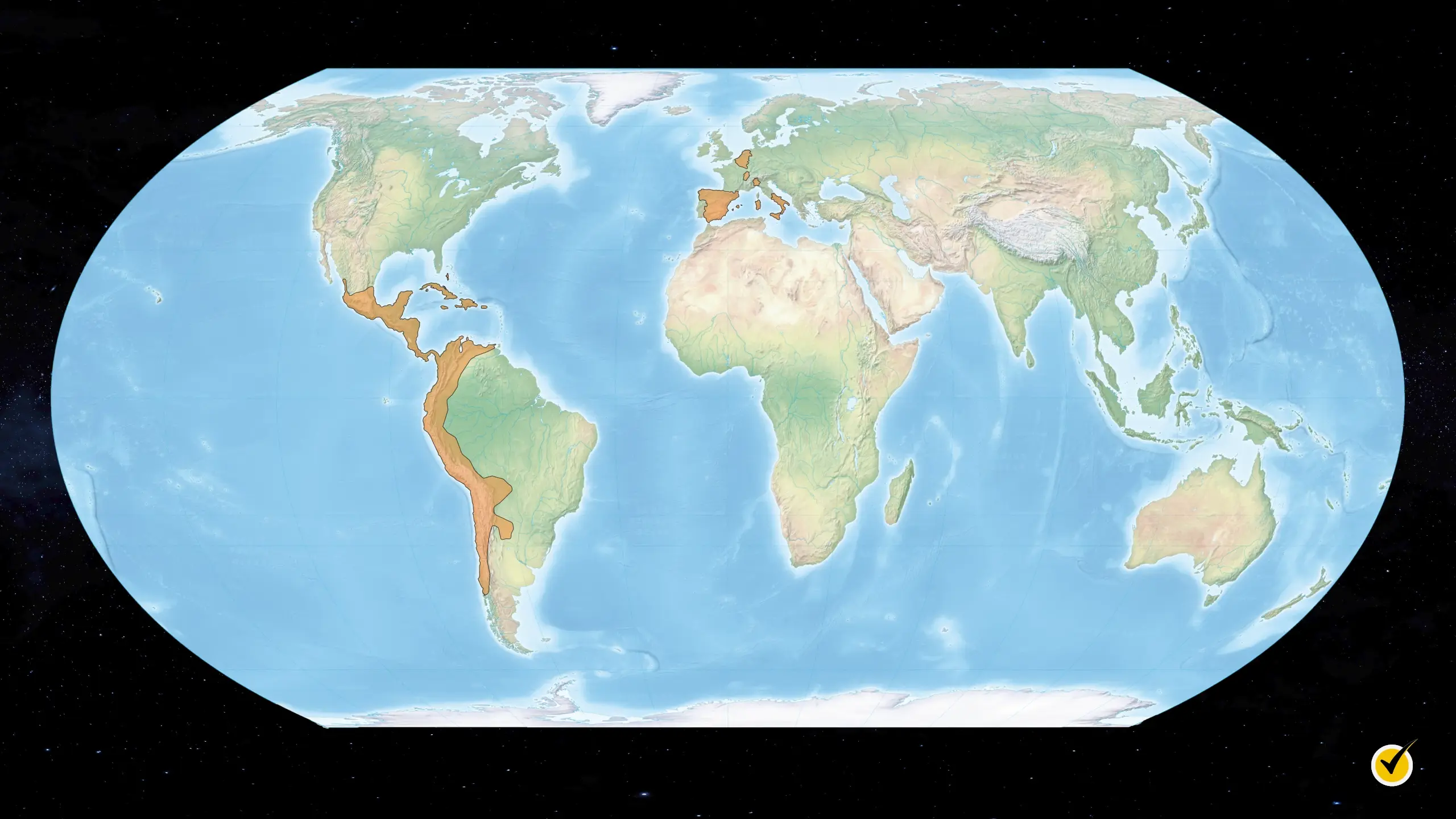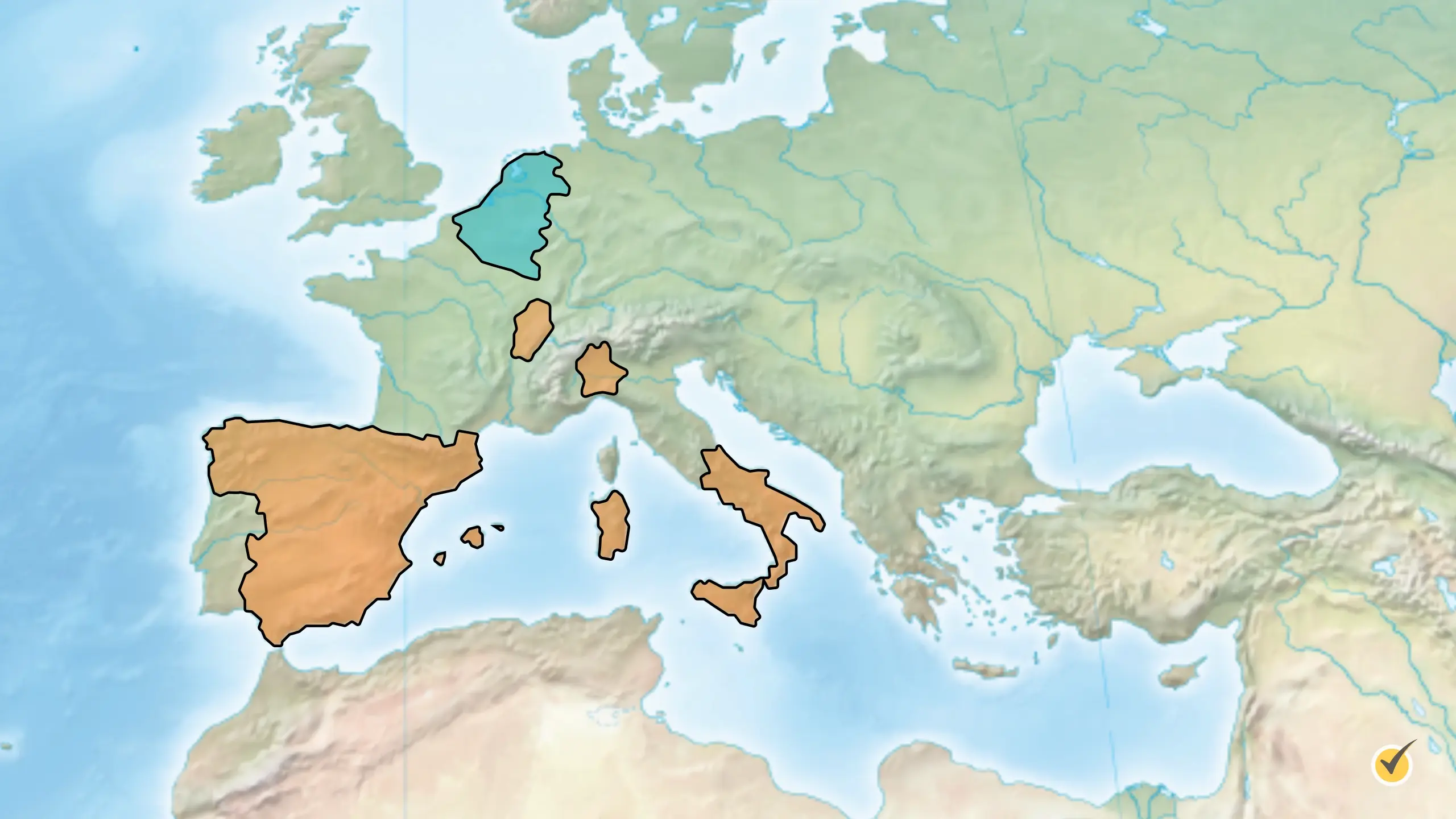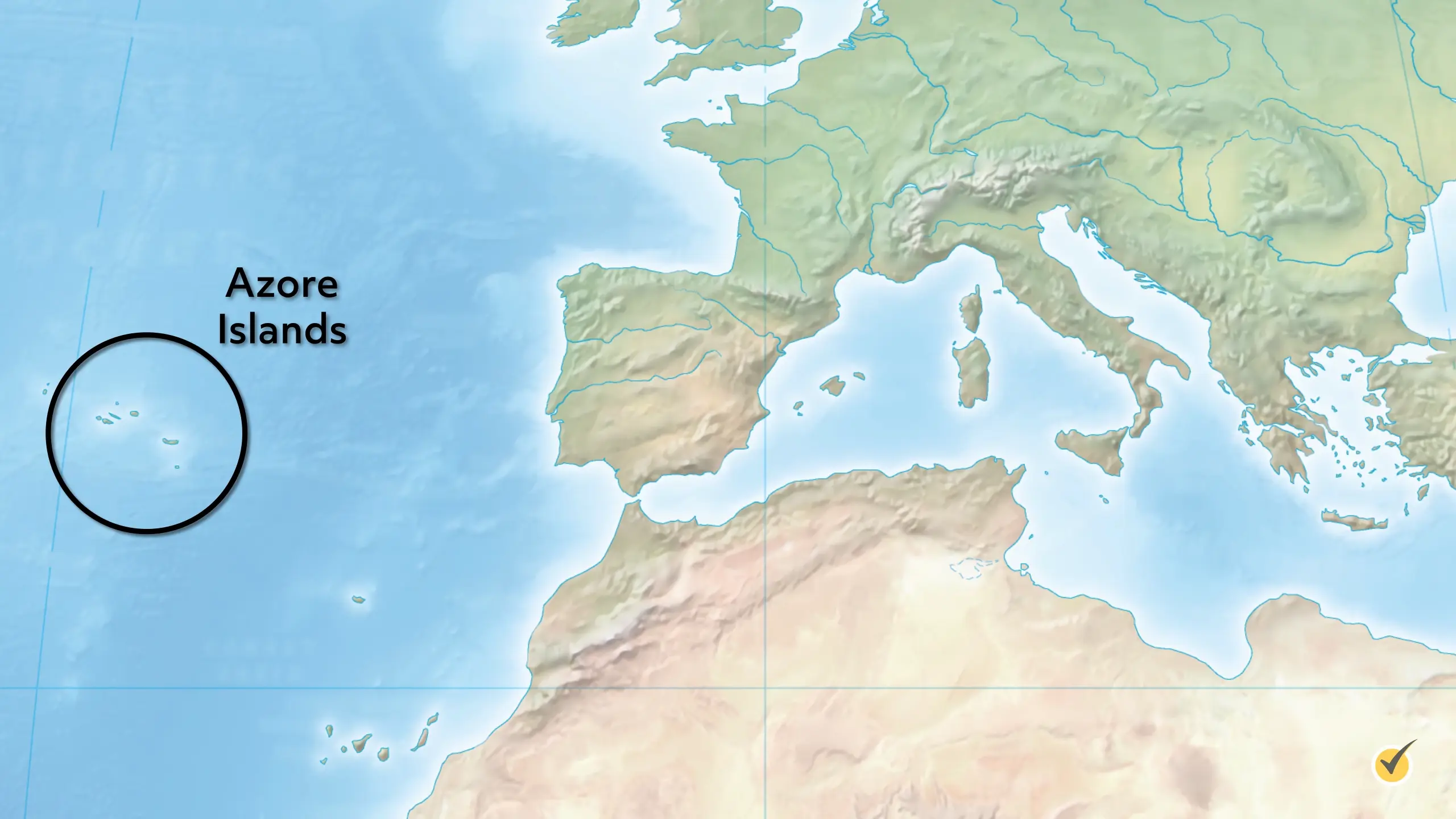
Hi, and welcome to this video on the powers of Spain in the 16th century!
In this video, we’ll examine the reigns of Isabella and Ferdinand, Charles, and Philip II. Along the way, we’ll look at the diplomatic, economic, military, and religious history of Spain in the 16th century.
Let’s get started!
The Formation of Spain
Spain, as we know it today, came into being at the end of the 15th century. It began with the union of Aragon and Castile through the marriage of Ferdinand and Isabella and ended with the completion of the Reconquista. The Reconquista was a near 800-year conflict between Christian and Muslim kingdoms in Iberia. The conquest of Granada in January 1492 saw the Iberian peninsula finally unified under Christian rule. As it would turn out, 1492 was a pivotal year in Spanish history.

The Rise of Spanish Power
Later that year Ferdinand and Isabella sponsored Christopher Columbus’ expedition to find a new route to the Indies. The fleet set off in August and reached the Bahamas two months later. The first colonies in the Caribbean were established at the turn of the century, paving the way for further expansion. An abundance of precious metals plundered from the American colonies saw tremendous wealth flow into Spain, which supported Spanish ambitions in Europe. This unexpected fortune transformed Spain from one of the poorer realms on the continent to the wealthiest.
The Habsburg Connection
Despite this upturn in fortunes, Queen Isabella’s final years were beset by tragedy and worry over succession. The premature deaths of her eldest children left the mentally fragile Joanna, who was married to Philip, the son of the Holy Roman Emperor Maximilian, next in line. This marital tie meant that their descendants would be included in the Habsburg line, thanks to their connection to Maximilian I. Joanna and Phillip assumed reign of Castile, but Philip died shortly afterward, in 1504, the same year Isabella died. Ferdinand, citing his daughter’s fragile mental health, assumed the role of regent until his death ten years later.
Imperial Ambitions and Conflicts
Ferdinand’s grandson, Charles, rose to the throne in 1516 a month before his 16th birthday. As well as the Netherlands, which he had already inherited from his father, Charles gained Naples, Sardinia, Sicily, and the great riches of the New World.
If that wasn’t enough, Charles also had a strong claim on becoming the new Holy Roman Emperor. His Italian holdings and imperial ambitions put him on a collision course with the King of France, Francis I. In 1519, Charles was unanimously chosen by the electors, earning the imperial crown and the lifelong hatred of Francis.
Before Charles could concentrate on his imperial obligations, he first had to secure his Spanish domain. He remained in Spain for seven years and accepted parliament’s choice of bride, Isabella of Portugal. Isabella was a popular and capable ruler who acted as regent during Charles’ many lengthy absences from Spain.
Wars with France and the Ottoman Threat
Wars with France were some of the reasons Charles was often away. He generally fared well in the course of these wars. The most notable victory occurred at Pavia in 1525; Francis’ army was annihilated and the king was taken prisoner. Within months of his release and marriage to Charles’ sister Eleanor, Francis was at war with the Habsburgs again as part of the League of Cognac.
Around the same time, an Ottoman invasion of Europe was underway. After conquering Hungary in 1526, the Ottomans reached Vienna in 1529. The defense of the city was aided by the presence of Spanish troops and the siege ultimately failed. The French and Ottomans would later combine forces to battle Habsburg influence in Europe. This odd alliance between a Catholic kingdom and Muslim empire proved to be remarkably durable, lasting until the end of the 18th century.
The Spanish Inquisition and the Protestant Reformation
Speaking of the Catholic church, religious matters were of considerable importance for every Spanish ruler of the 16th century. The Spanish Inquisition was founded in 1478 during the reigns of Isabella and Ferdinand. The aim of this group of institutions was to combat heresy. After the conquest of Granada, subjects were offered the choice of conversion or expulsion. By the mid-16th century, the Inquisition had acquired a new target: the Protestant Reformation.
Charles was a staunch opponent of the Reformation. Martin Luther, known as the catalyst of the reformation, wrote a somewhat controversial pamphlet called The Ninety-Five Theses, which detailed the issues Luther had with the church. In 1522, Charles issued a decree known as the Edict of Worms, which denounced Martin Luther as a heretic and enemy of the state. In 1545, at Charles’ urging, the Council of Trent met in Italy to discuss the church’s response to the Reformation. Over the next 18 years, a series of decrees would be issued, shaping the course of the Counter-Reformation.
Toward the end of his reign, Charles turned his attention to securing the succession of his son Philip to the throne of the Holy Roman Empire, in addition to the territory he was already heir to. He wrote a lengthy guide for his heir on how to rule, and tried his best to ensure Philip’s succession, but was ultimately unsuccessful. Charles resigned in 1556 and lived his final years in a monastery repairing clocks and overeating.
Philip’s Global Empire
Philip inherited a vast empire, which would grow even larger and reach the height of its power under his reign. He enjoyed a major victory over France in 1557, and just two years later, the final Italian War ended, bringing 65 years of warfare to an end. In 1561, Philip permanently relocated to Madrid and began construction of El Escorial.

El Escorial was a great library, palace, monastery, and mausoleum for the Habsburgs. The pressure of its construction was too much for the project’s first architect, who worked himself to death by 1567. Juan de Herrera assumed responsibility and rose to become Philip’s Royal Steward.
Herrera was one of several bureaucrats who managed the complex day-to-day running of Philip’s global empire. Philip initiated a gigantic research project to learn more about his ever-growing domains through the distribution of thousands of questionnaires. These included oral histories taken from tribal elders in the Americas, capturing a treasure trove of knowledge for future scholars.
The Dutch Revolt
The struggles with the Ottomans continued during all of this, primarily in the Mediterranean. There were key victories for Philip, such as the siege of Malta in 1565 and the annihilation of an Ottoman fleet at Lepanto in 1571, but there were also Ottoman victories throughout North Africa. However, the costliest military venture of Philip’s reign was the Netherlands.

Philip delegated rule of the Netherlands to his illegitimate half-sister Margaret in 1559 but by 1566 religious tension was boiling over. An army commanded by the Duke of Alba was dispatched to restore order. Alba was an able commander but unable to defuse the situation. The brutal suppression of his soldiers only heightened resistance. During the siege of Haarlem, so many Spanish troops died that the Dutch defenders raised a mock grave on the city walls.
When the city finally fell, the inhabitants were massacred, paying dearly for the earlier bravado. The struggle with the Dutch dragged on for 80 years. Supporting the war effort from Madrid was terribly expensive, but advances in silver mining saw a large increase in silver coming from Peru, which kept the Spanish army in the field. Though hardly worth such a lengthy and expensive conflict, the Netherlands was a matter of pride for the Habsburg dynasty.
By 1580, the Duke of Alba was once again on the march to secure Philip’s claim upon the Portuguese throne. Philip was crowned King of Portugal the following year, and naval victories gained the Azore islands in 1582.

The Spanish Armada and the Decline of Spanish Power
Philip’s empire was vast and quickly becoming overstretched and difficult to manage financially. This made the flow of gold from the New World an awfully tempting target for privateers. Privateers were armed ships held by private individuals who had commissions from the government. Francis Drake was the most notable of the government-sanctioned pirates. The English sailor raided Spanish colonies in the Caribbean and attacked Cádiz in 1587.
After the execution of Mary Queen of Scots gave Philip a claim for the English throne, he gathered a large fleet to invade England in 1588. The Spanish Armada was shattered, but more by the weather than the English fleet. After an inconclusive battle, the Spanish ships were scattered and few made it back to Spain. Two further fleets succumbed to bad weather in 1596 and again in 1597.
Philip’s death in 1598 brought an incredibly successful 42-year reign to an end. Historians generally regard the end of Philip’s reign as the beginning of a long decline in Spanish fortunes.
Review
Okay, now that we’ve covered the state of Europe in the 16th century, here’s a quick recap:
The joint rule of Isabella and Ferdinand unified Aragon and Castile and ended the Reconquista. Their grandson Charles became Holy Roman Emperor and oversaw great expansions to Spanish colonies in the Americas and the creation of a complex legal system. His son Philip’s long reign saw even further expansion and the creation of an efficient bureaucracy.
I hope this review was helpful! Thanks for watching, and happy studying!
